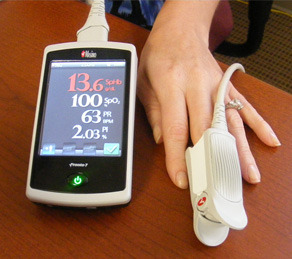The group at the University of Arizona has been fooling around with an instant-read hemoglobin monitor manufactured by Masimo Corp, the Pronto-7. Interesting little device. It’s a hand-held unit that looks like it uses near-infrared light to calculate the hemoglobin concentration. An optical probe is applied to a finger (like an oximeter probe), and the result is displayed almost immediately. It can also be printed or emailed.

Previous iterations of this technology for continuous readings did not correlate well with invasive blood draws. Use of an instant-read system in trauma patients has not been explored to date. The Arizona group looked at the correlation between the results of the Pronto-7 and the usual blood draw in acute trauma patients using a prospective design. Three spot-check results were obtained for every invasive blood draw.
Here are the factoids:
- 525 patients were spot-checked, with a success rate of 86% (no explanation why!)
- 173 (38%) of patients had a Hgb <= 8
- The mean difference between spot-check and blood draw results was only 0.1 g/dL (!)
- Sensitivity was 96%, accuracy 77%
Bottom line: This is an interesting new tool for acute trauma care. The only downside that I see is that we may lose sight of the fact that hemoglobin values lag behind the true blood volume in rapidly bleeding patients. We mustn’t be fooled into thinking that everything is fine just because a number is normal. There’s still room for common sense!
Related post:
Reference: Transforming hemoglobin measurement in trauma patients: non-invasive spot check hemoglobin. EAST 2014, poster #20.
I have no financial interest in Masimo Corp.

